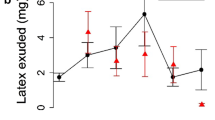Abstract
Both induced and maternal effects may create delayed negative feedback on the population growth of herbivorous insects. I tested for these effects in a chronically dense population of tussock moths (Orgyia vetusta) feeding on bush lupines (Lupinus arboreus). Experimental bushes received different realistic levels of defoliation by tussock moths in the preceding year, and experimental moth larvae came from mothers that had experienced either high or low levels of crowding as larvae in the previous year. Weight of female moths at pupation was not affected by prior foliar damage, and showed only a weak (12%) effect of maternal crowding. Rates of early larval disappearance, from aerial dispersal (“ballooning”) or other causes, were unaffected by either foliar damage or maternal crowding, and were very low except when larvae were placed on dead bushes. These results help to explain why the tussock moth population has maintained high densities at the study site for >10 years.
Similar content being viewed by others
References
Baltensweiler W, Benz G, Bovey P, and Delucchi V (1977) Dynamics of larch bud moth populations. Annu Rev Entomol 22:79–100
Barbosa P, Krischik V, Lance D (1989) Life-history traits of forest-inhabiting flightless Lepidoptera. Am Midl Nat 122:262–274
Barbour MG, Craig RB, Drysdale FR, Ghiselin MT (1973) Coastal ecology, Bodega Head. University of California Press, Berkeley
Bentley B, Johnson N (1991) Plants as food for herbivores: the roles of nitrogen and CO2 enrichment. In: Price PW, Lewinsohn TM, Wilson GW, Benson WW (eds) Plant-animal interactions: evolutionary ecology in tropical and temperate regions. Wiley, New York, pp 257–272
Berryman AA (1978) Population cycles of the Douglas-fir tussock moth (Lepidoptera: Lymantriidae): the time-delay hypothesis. Can Entomol 110:513–518
Berryman AA (1987) The theory and classification of outbreaks. In: Barbosa P, Schultz JC (eds) Insect outbreaks. Academic Press, New York, pp 3–30
Campbell RW (1981) Population dynamics: historical review. In: Doane CD, McManus ML (eds) The gypsy moth: research toward integrated pest management. Tech Bull No. 1584, United States Department of Agriculture, Washington, DC, pp 65–86
Capinera JL (1979) Qualitative variation in plants and insects: effects of propagule size on ecological plasticity. Am Nat 114:350–361
Davidson ED, Barbour MG (1977) Germination, establishment and demography of coastal bush lupine (Lupinus arboreus) at Bodega Head, California. Ecology 58:592–600
Edelstein-Keshet L, Rausher MD (1989) The effects of inducible plant defenses on herbivore populations. I. Mobile herbivores in continuous time. Am Nat 133:787–810
Elkinton JS, Liebhold AM (1990) Population dynamics of gypsy moth in North America. Annu Rev Entomol 35:571–596
Fowler SV, Lawton JH (1985) Induced defenses and talking trees: the devil's advocate position. Am Nat 126:181–195
Furniss MM, Knopf JAE (1971) The western tussock moth. USDA Forest Service, Forest Pest Leaflet No. 120
Harrison S (1994) Resources and dispersal as factors limiting a population of the tussock moth (Orgyia vetusta), a flightless defoliator. Oecologia 99:27–34
Harrison S, Karban R (1986) Effects of an early-season folivorous moth on the success of a later-season species, mediated by a change in the quality of the shared host, Lupinus arboreus Sims. Oecologia 69:354–359
Harrison S, Maron JL (1995) Impacts of defoliation by tussock moths (Orgyia vetusta) on the growth and reproduction of bush lupine (Lupinus arboreus). Ecol Entomol 20: (in press)
Harrison S, Wilcox C (1995) Evidence that predator satiation may restrict the spatial spread of a tussock moth (Orgyia vetusta) outbreak. Oecologia, 101:309–316
Haukioja E (1980) On the role of plant defenses in the fluctuation of herbivore populations. Oikos 35:202–213
Haukioja E, Neuvonen S (1987) Insect population dynamics and the induction of plant resistance: the testing of hypotheses. In: Barbosa P, Schultz JC (eds) Insect outbreaks. Academic Press, New York, pp 411–432
Hickman JC (1993) The Jepson manual: higher plants of California. University of California Press, Berkeley
Karban R, Myers JH (1989) Induced plant responses to herbivory. Ann Rev Ecol Syst 20:331–348
Leonard DE (1968) Effects of density of larvae on the biology of the gypsy moth (Porthetria dispar). Entomol Exp Appl 11: 291–304
Leonard DE (1970) Intrinsic factors causing qualitative changes in populations of Porthetria dispar (Lepidoptera: Lymantriidae). Can Entomol 102:239–249
Mason RR, McManus ML (1981) Larval dispersal of the gypsy moth. In: Doane CD, McManus ML (eds) The gypsy moth: research toward integrated pest management. Tech Bull No. 1584, United States Department of Agriculture, Washington DC, pp 161–202
May RM (1973) Stability and complexity in model ecosystems. Princeton University Press, Princeton
Myers JH, Williams KS (1984) Does tent caterpillar attack reduce the food quality of red alder foliage? Oecologia 62:74–79
Peters TM, Barbosa P (1977) Influence of population density on size, fecundity, and developmental rate of insects in culture. Annu Rev Entomol 22:431–450
Roff DA (1990) The evolution of flightlessness in insects. Ecol Monogr 60:389–421
Rossiter MC (1991) Environmentally based maternal effects: a hidden force in insect population dynamics? Oecologia 87: 288–294
Rossiter MC (1993) The impact of resource variation on population quality in herbivorous insects: a critical aspect of population dynamics. In: Hunter MD, Ohgushi T, Price PW (eds) Effects of resource distribution on animal-plant interactions. Academic Press, New York, pp 13–42
Sokal RR, Rohlf FJ (1981) Biometry. Freeman, New York
Turchin P (1990) Rarity of density dependence or population regulation with time lags? Nature 344:660–663
Wellington WC (1965) Some maternal influences on progeny quality in the western tent caterpillar (Malacosoma pluviale Dyar.). Can Entomol 97:1–14
Wickman BE, Beckwith RC (1978) Life History and habits. In: Brookes MH, Stark RW, Campbell RW, The Douglas-fir tussock moth: a synthesis. Tech Rep 1585 United States, Department of Agriculture
Wilkinson L (1990) SYSTAT: the system for statistics. Systat Inc., Evanston, II
Author information
Authors and Affiliations
Rights and permissions
About this article
Cite this article
Harrison, S. Lack of strong induced or maternal effects in tussock moths (Orgyia vetusta) on bush lupine (Lupinus arboreus). Oecologia 103, 343–348 (1995). https://doi.org/10.1007/BF00328623
Received:
Accepted:
Issue Date:
DOI: https://doi.org/10.1007/BF00328623




